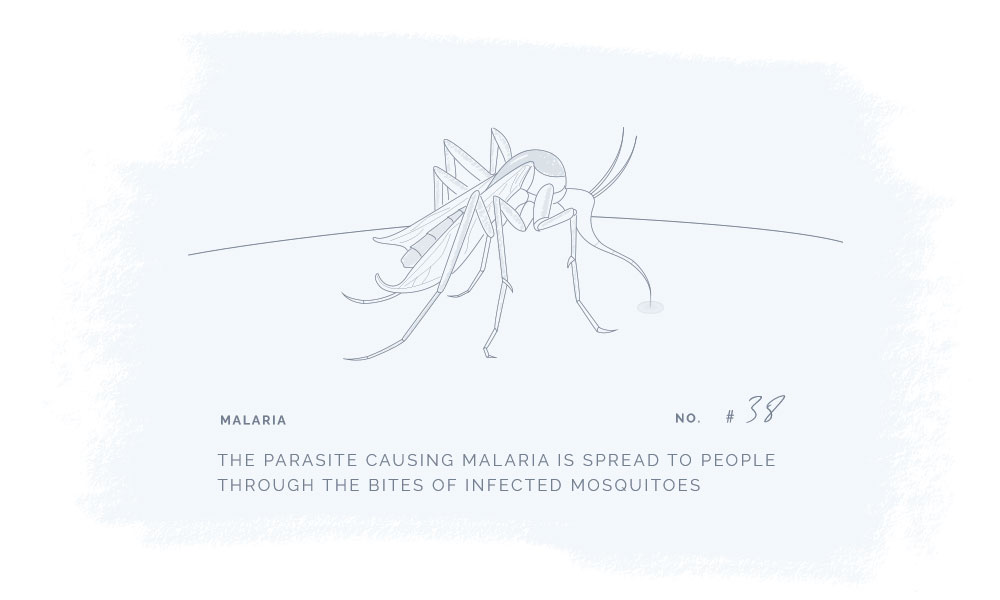Psoriasis
Category
Infectious
REVIEWED BY
Our Biomedical Scientist
Reviewed based on
Literature Discussion
Last update
November 2020

What is Malaria
Plasmodium species cause a parasitic disease known as malaria. This disease can be transmitted when infected mosquitos bite an uninfected person. 1,2
When the parasites enter the body, they migrate to the liver and can remain there for one year. After the parasites have matured, they leave the liver and target red blood cells (i.e. they get infected). Malaria infection causes a high fever and shaking chills. Furthermore, malaria parasites are resistant to the most common drugs that are used to treat patients suffering from the disease. Malaria is primarily found in tropical- and subtropical climates and may be fatal without medical attention.3
Symptoms
Signs and symptoms of malaria typically begin within a few weeks after the bite from an infected mosquito. However, some type of malaria parasites can lie dormant in the body for up to a year. Malaria infection may be experienced as cycles of attacks with symptoms increasing and decreasing.
Primary signs of malaria infection may be:3
- High fever
- chills
- Headache
- Nausea and purging
- Fatigue
- Muscle pain
Severe malaria
Some malaria infections are so urgent and aggressive that they must be treated as a medical emergency. For example, cerebral malaria infection is considered a medical emergency as it may cause:4
- Abnormal behavior
- Impaired consciousness
- Seizures and/or coma
- Neurologic abnormalities
Cause
The transmission cycle of the mosquito helps explain why malaria is still present in tropical- and subtropical climates and how the infection spreads.3
- An infected human transmits malaria parasites to an uninfected mosquito
- The mosquito is now infected and can transmit and spread malaria parasites through its bites
- When the mosquito transmits its malaria parasite to humans, the parasites travel to the liver where it can lie dormant for up to 1 year
- As malaria parasites develop and mature they leave the liver and begin to infect red blood cells. In this stage, symptoms of malaria typically start to develop
- When malaria parasites have infected red blood cells, malaria patients can transmit the virus to an uninfected mosquito, starting the cycle again.
- It is noteworthy that malaria infection can be transmitted from mother to unborn child, through blood transfusions and injections with contaminated needles.
The connection between Cannabinoids & Malaria
Studies find that CBD and THC may have great therapeutic potential and may be used to help treat Malaria. CBD and THC are well-known cannabinoids, however, they do not have the same psychoactive effects. THC is psychoactive while CBD does not possess psychoactive effects. According to WHO guidelines, the cannabidiol CBD is generally well tolerated with a good safety profile.
Preclinical data proposes that the cannabinoids THC and CBD may be therapeutic in the treatment of malaria. Especially CBD may potentially be beneficial in the treatment of malaria infections as CBD may possess neuroprotective and anti-inflammatory properties.5
In a cerebral malaria model, it was shown that CBD has neuroprotective properties and might produce beneficial effects as an adjunctive therapy to prevent neurological symptoms following this disease.6
The literature discussion is an overview of the published results from scientific studies investigating if and how cannabinoids can be beneficial in the treatment of Malaria. The overview will be updated regularly to ensure the newest and most accurate information.
Anandamide and CBD reduce parasitemia and increase survival in mice
It was shown that anandamide decreased parasitemia and enhanced the survival rate of infected mice via the acceleration of eryptosis of infected erythrocytes.7
In a different study, the survival rate of infected mice was also increased by CBD compared to the control group. CBD combination with the anti-malarial drug Artesunate was shown to inhibit the long-term cognitive deficits induced by the disease in mice. The mechanism underlying these effects is connected to neuroprotective and anti-inflammatory activities of CBD.6
In mice, parasitemia was shown to be reduced from ±37% to ±24% by 5 mg/kg subcutaneous anandamide. Also, 21-day survival was increased from 0% to 67% by 5 mg/kg subcutaneous anandamide in mice.7
Clinical trials are research studies that examine new treatments and evaluate their effects on human health outcomes.
Today, we are not able to provide any clinical trials about cannabinoids and Malaria.
- https://www.sciencedirect.com/topics/neuroscience/malaria
- https://www.who.int/ith/diseases/malaria/en/
- https://www.mayoclinic.org/diseases-conditions/malaria/symptoms-causes/syc-20351184
- https://www.cdc.gov/malaria/about/disease.html
- https://ghmedical.com/endocannabinoid-system/diseases/malaria
- Campos, A.C., (2015). “Cannabidiol increases survival and promotes rescue of cognitive function in a murine model of cerebral malaria”. https://pubmed.ncbi.nlm.nih.gov/25595981/
- Bobbala, D., Et Al., (2010). “Effect of anandamide in Plasmodium Berghei-infected mice”. https://pubmed.ncbi.nlm.nih.gov/20798520/
CANNABINOIDS & RECEPTORS
Below you find the plant cannabinoids, cannabinoid receptors, and endocannabinoids that are associated with the potential therapy.
If you have any further information relevant to the connection between Malaria and cannabinoids or find any of the information inaccurate, outdated or incomplete please contact us here.

